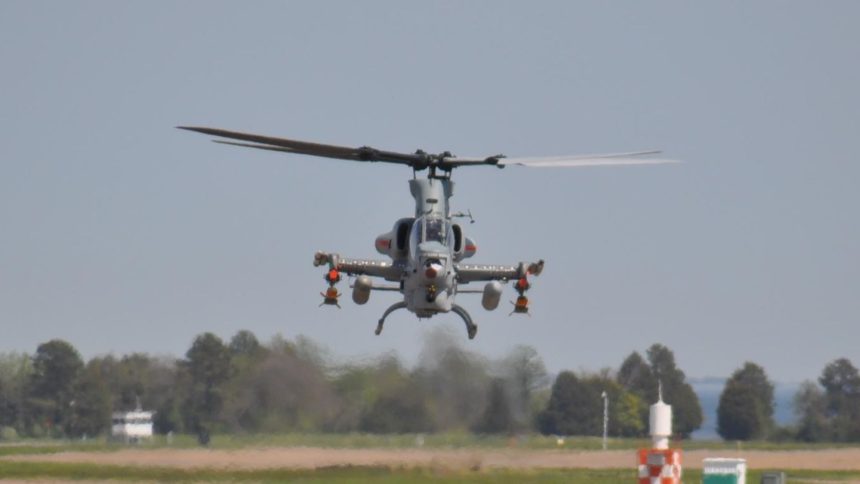The USMC identified L3Harris’ modular Red Wolf family of ‘launched effects’ as the munition at the center of the Long Range Attack Missile program.
The U.S. Marine Corps has identified as the L3Harris Red Wolf the mystery missile which was test-fired off an AH-1Z Viper attack helicopter in Nov. 2024 as part of a Long-Range Precision Fire (LRPF) test at the Yuma Proving Grounds in Arizona. The munition is a part of a family of ‘launched effects’, which can be used either in kinetic roles, for conventional strikes, or non-kinetic roles, such as communications relays, in the service’s Long-Range Attack Missile (LRAM) project within the broader Precision Attack Strike Missile (PASM) Program of Record.
Marine Col. Scott Shadforth confirmed this to The War Zone at the annual Modern Day Marine exposition. It has also emerged that Red Wolf was originally secretly developed for the Pentagon’s Strategic Capabilities Office (SCO) and first used at the U.S. Army’s Experimentation Demonstration Gateway Event in 2021 (EDGE 21).
L3Harris also revealed that the missile has undergone over 35 flights, and the production line is already active and scalable for the future. Red Wolf is capable of performing “precision strikes, surveillance, electronic warfare, decoy operations and target tracking,” while being employed by crewed, uncrewed, fixed or rotary-wing aircraft, as well as ground launchers.
While no pictures of the Red Wolf were released, Aviation Week’s report on EDGE 21 said that the munition was a six-foot-long design powered by an unspecified German-made turbojet and capable of being launched by an MQ-1C Gray Eagle drone. The report also added it functioned as a “communications relay.”
However, a photo shared on X appears to show the actual Red Wolf munition on exposition during the U.S. Army’s Project Convergence – Capstone 4 multinational exercise in 2024. The photo shows the weapon having a faceted body, equipped with folding wings, four tail fins, as well as a small inlet and a larger nozzle for the engine.
I think I saw a picture of Red Wolf at PC-C4 https://t.co/Jd14a2p37g pic.twitter.com/ccv42tdffo
— 笑脸男人 (@lfx160219) May 2, 2025
November 2024 test
When NAVAIR (Naval Air Systems Command) announced on Feb. 23, 2025, the November 2024 LRPF test, the Director of Expeditionary Maritime Aviation – Advanced Development Team (XMA-ADT), Col. Scott Shadworth, described the missile as useful for “maritime and land-based targets” and as a “cost-effective” weapon.
The description was consistent with the first live-fire of an AGM-179 JAGM (Joint Air-to-Ground Missile) by a Marine Viper in the Indo-Pacific region off the Okinawan coast on Jun. 26, 2024, suggesting the Corps’ vision of the Vipers conducting light, disabling strikes on PLA Navy shipping and bases in the South China Sea (SCS).
The official picture released on that occasion showed only two then-unidentified Red Wolf missiles hanging off each of the Viper’s stub wings. The service also added that a MAGTAB (Marine Air-Ground Tablet) was used for the first time by a Marine rotary-wing platform while firing the weapon.
As details in that NAVAIR release were scarce, we assessed that the MAGTAB may have been used to mark the target location on the common map interface, with the tablet possibly used by both the Viper’s WSO (Weapon System Operator) and a Marine on the ground. We drew that conclusion based on the tablet’s description in Marine releases since 2019, when it was first introduced, with upgraded versions appearing subsequently.

Need for long-range Air Launched Effects
Shadforth now told The War Zone, on the sidelines of Modern Day Marine, that the LRAM, currently based on the Red Wolf, is a “defense innovator accelerator” under the broader PASM, with a “low triple-digit range” and “double-digit time of flight,” implying a subsonic speed.
TWZ added that the Corps previously has expressed a need to be able to reach ranges of 170 miles (278 kilometers), and the Red Wolf appears to be capable of reaching that distance. Extended range variants of the Hellfire, like the AGM-114R-4, or the JAGM’s ‘MR’ version have maximum ranges of 21 miles and 10 miles respectively, which are drastically shorter than what the Corps desires.
L3Harris claims the weapon has high subsonic speeds, a 200+ nautical mile range at low altitudes and an endurance of over 60 minutes.
Shadforth further told TWZ: “The opportunity that LRAM provides is the modularity that can come with it. So kinetic (and) non-kinetic capabilities. And then we can certainly get into an open debate of, is it a weapon? Is it an air-launched effect? Is it a UAS (uncrewed aerial system; drone)? How are we defining those capabilities?”
ALTIUS trials in connection to WILDCAT date back all the way to 2022. The photos show the “tube” air launch from US Army helicopters.
Land HQ / Army Air Corps have a small budget for Air Launched Effects of their own and there was a recent, ambitious ALE call via DASA, too. pic.twitter.com/sPj9FJQQIC
— Gabriele Molinelli (@Gabriel64869839) March 6, 2025
Tactical use
Tactically, Vipers firing Red Wolf – or any other ‘kinetic’ or ‘non-kinetic’ missile selected by the service under the LRAM/PASM program – cuts costs, complexity and adds to the maritime strike missions in the western Pacific. Red Wolf striking the main sensor masts of PLAN warships will at least temporarily blind them to a lot of incoming threats, something which could be exploited by follow-on, synchronized strikes with the larger NMESIS or Super Hornets and F-35Cs firing AGM-158C LRASM (Long-Range Anti-Ship Missiles) or the JSM (Joint Strike Missile).
The SkyTower II (STII) pod on the Corps’ MQ-9 Reaper drones could also come into play. This creates what Marine Col. Nathan Marvel told TWZ in 2023 about the continued relevance of AH-1Z and the UH-1Y in a war with China, requiring “kill webs” and not “kill chains.”
Having multiple networks and nodes, instead of a single sensor-to-shooter sequence, appears to be the emerging concept. The LRAM’s “modularity” mentioned by Shadforth could also allow for rapid scaling, bringing affordable mass to bear down on the PLA Navy, also informed by valuable lessons from the current war against the Houthis in the Red Sea.

Communications relays to direct fire
The idea is basically to lend the exquisite kinetic and non-kinetic capabilities of fixed-wing aircraft to rotary-wing craft, according to Marvel. The USMC’s STII on its MQ-9s Block 5 and the MAGTAB have complementing capabilities in the realm of communications relays.
The STII airborne network extension pod “enhances cross-domain communication capabilities and links communications between disparate forces.” The MAGTAB, meanwhile, relays messages, texts and video data in addition to existing radio systems, for “quieter and efficient long-distance communication,” allowing to reduce “location errors due to misreading a paper map.”
#Marines with Marine Aircraft Group (MAG) 39, @3rdmaw, fire an AGM-179 Joint Air-to-Ground Missile at a moving maritime target from an AH-1Z Viper over the Pacific Ocean, Dec. 7.#MAG39 conducts sea denial exercises to enable littoral operations in contested environments. pic.twitter.com/dechlHqvxS
— U.S. Marines (@USMC) December 17, 2022
It would not be far-fetched to imagine Marine’s STII-equipped Reapers, non-kinetic Red Wolfs and MAGTABs relaying quick communications, directing anti-shipping fire from either the Marine Littoral Regiments’ NMESIS, or the kinetic Red Wolf. The communications-centric capability of these three systems cannot be a coincidence and future public or secret exercises, or additional orders for three will shed light if they share a relationship.









